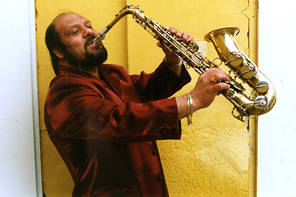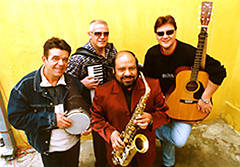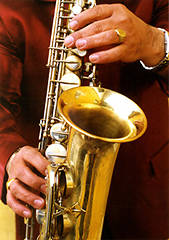 I
first met Ferus Mustafov in April 1991, just before Yugoslavia
fell apart and the wars started and before his first concert for the
world music audience (the Druga godba festival, Ljubljana, May 1991).
At that time he was at the top of his popularity. The cassette Ferus
Mustafov & his guests (Diskos 1990), produced in his small home-studio,
had sold in about 100.000 copies on the huge Yugoslav and Balkan markets.
Like most of the significant gypsy musicians Ferus (1950) was born in
a musical family. His father Ilmi Jasarov was an important Macedonian
gypsy musician, who actually introduced saxophone into Macedonian gipsy
music. Of course, he was the first teacher of Ferus. Ferus went to musical
school in his hometown Stip. It is interesting at first he took violin
classes. Very soon he moved from violin to clarinet and from musical
school to the school of a musician playing constantly at weddings and
restaurants. His progress was fast and already at the age of 17 he started
touring around Yugoslavia.
I
first met Ferus Mustafov in April 1991, just before Yugoslavia
fell apart and the wars started and before his first concert for the
world music audience (the Druga godba festival, Ljubljana, May 1991).
At that time he was at the top of his popularity. The cassette Ferus
Mustafov & his guests (Diskos 1990), produced in his small home-studio,
had sold in about 100.000 copies on the huge Yugoslav and Balkan markets.
Like most of the significant gypsy musicians Ferus (1950) was born in
a musical family. His father Ilmi Jasarov was an important Macedonian
gypsy musician, who actually introduced saxophone into Macedonian gipsy
music. Of course, he was the first teacher of Ferus. Ferus went to musical
school in his hometown Stip. It is interesting at first he took violin
classes. Very soon he moved from violin to clarinet and from musical
school to the school of a musician playing constantly at weddings and
restaurants. His progress was fast and already at the age of 17 he started
touring around Yugoslavia.
The first records of Ferus (mainly singles) date back to the beginning
of the 70's. He also cooperated with Esma & Ensemble Teodosievski
on their "psychedelic" Svatba LP (RTB 1972). It is interesting that
Ferus won wider recognition only after he had moved from Skopje to Sarajevo.
In the first half of the 80's Sarajevo was a bustling town with its
own unique vivid spirit, giving special touch to the Winter Olympics
of 1984 (and later even surviving the horrors of the siege in the war
in Bosnia in the 90's), and one of the most important and creative centers
of the Yugoslav folk-pop music. There Ferus recorded his most important
work of the 80's, the LP Ora i coceci (RTB 1984). Already on it he captures
us with his imaginative, introspective and skilful oriental improvisations
and Bulgarian wedding folk speed-core and Macedonian blues.
 During
my first meeting with Ferus I was still a 90% proof rocker, whose dreams
had turned to reality by getting the job of a local tour manager for
Motorhead just a year ago. I was definitely impressed by the image of
Ferus. He was clad in black leather, he wore black glasses, he drove
fast. Already during the Druga godba festival I was amazed to realize
he definitely liked playing fast and loud music and that he was also
a great master of intimate oriental tunes. Yet the Ferus rise to the
world music scene was not a quick one, also because the wars in Yugoslavia
in the early 90's stopped all the communications in the area. For awhile
it was even complicated and extremely expensive to make a phone call
to Macedonia. Only after I had got acquainted with Hijaz Mustapha in
1993, his carreer started moving onwards. In 1994 Ferus performed with
his band at the Berlin Heimatklange festival and played with Klezmatics
on Totem and Tabu Tour. In 1995 his first Western European record was
released, King Ferus (Globestyle), produced by the excellent Hijaz Mustapha.
Since its release Ferus has performed widely in Germany (also at Bardentreffen
festival in Nurnberg and at Folkherbst in Plauen, winning its audience
award in 1995), Nordic countries (Roskilde and Re:Orient festivals),
Benelux (also Sfinx and Gent festivals), France, Italy, Spain, Greece,...
He has been also active in many other fields, working as an editor at
the central Macedonian Roma TV, building a big studio in his hometown
Skopje, playing constantly for the Macedonians gipsies between Goteborg,
Chicago and Sidney, and releasing an avalanche of local cassettes and
recently CDs.
During
my first meeting with Ferus I was still a 90% proof rocker, whose dreams
had turned to reality by getting the job of a local tour manager for
Motorhead just a year ago. I was definitely impressed by the image of
Ferus. He was clad in black leather, he wore black glasses, he drove
fast. Already during the Druga godba festival I was amazed to realize
he definitely liked playing fast and loud music and that he was also
a great master of intimate oriental tunes. Yet the Ferus rise to the
world music scene was not a quick one, also because the wars in Yugoslavia
in the early 90's stopped all the communications in the area. For awhile
it was even complicated and extremely expensive to make a phone call
to Macedonia. Only after I had got acquainted with Hijaz Mustapha in
1993, his carreer started moving onwards. In 1994 Ferus performed with
his band at the Berlin Heimatklange festival and played with Klezmatics
on Totem and Tabu Tour. In 1995 his first Western European record was
released, King Ferus (Globestyle), produced by the excellent Hijaz Mustapha.
Since its release Ferus has performed widely in Germany (also at Bardentreffen
festival in Nurnberg and at Folkherbst in Plauen, winning its audience
award in 1995), Nordic countries (Roskilde and Re:Orient festivals),
Benelux (also Sfinx and Gent festivals), France, Italy, Spain, Greece,...
He has been also active in many other fields, working as an editor at
the central Macedonian Roma TV, building a big studio in his hometown
Skopje, playing constantly for the Macedonians gipsies between Goteborg,
Chicago and Sidney, and releasing an avalanche of local cassettes and
recently CDs.
(The Former Yugoslav Republic of) Macedonia is one of the musical gems
of the Balkans. A small state, which, after Yugoslavia had disintegrated
in 1991, found itself caught in the middle of not always friendly neighbours
- Greece, Albania, Kosovo, Serbia and Bulgaria. Its population is a
mixture of ethnic groups, consisting of the Slavic Macedonian majority,
a large Albanian minority, Vlachs (a Balkan ethnic group speaking a
Romance language), Turks, Serbs and Rom or gypsy population. The growing
pressures of Albanians upon the Macedonian majority started a civil
war in 2001, yet the conflict was put out by the international community
in the very last moment, before it could spread. On the other hand,
the country where so many diverse traditions meet abounds in overwhelming
cultural treasures. Macedonian music with its specific beats of 7/8,
9/8 or 11/8 and Orthodox and Oriental Balkan blues and soul is definitely
one of them.
 There
are about 240.000 Rom inhabitants in Macedonia. Its largest settlement
is Suto orizari (rice fields), a suburb of the Macedonian capital Skopje.
If you take the town bus 19 bringing you directly to its center, you
fall into a unique oriental Rom ambient so that you quickly forget that
you are only two bus stops away from the Skopje area of blocks of flats,
It was exploited by the film director Emir Kusturica in his film hit
The Time of The Gypsies. And if you plan to travel there definitely
do it in the months of May, June, September or October, when the local
weddings move to its streets. During weekends you will not have problems
in finding them. The sounds of wailing saxophones and clarinets, of
keyboards imitating a kanun or sounding archaic like the Moog synthesiser
of the early 70's and of the weeping singers trying to sing like the
latest Turkish arabeque pop hero are its regular soundtrack. Even though
Ferus Mustafov rarely performs on the streets of Suto Orizari these
days, he is still the king of its fast and loud wedding sound, imitated
by hundreds of young musicians.
There
are about 240.000 Rom inhabitants in Macedonia. Its largest settlement
is Suto orizari (rice fields), a suburb of the Macedonian capital Skopje.
If you take the town bus 19 bringing you directly to its center, you
fall into a unique oriental Rom ambient so that you quickly forget that
you are only two bus stops away from the Skopje area of blocks of flats,
It was exploited by the film director Emir Kusturica in his film hit
The Time of The Gypsies. And if you plan to travel there definitely
do it in the months of May, June, September or October, when the local
weddings move to its streets. During weekends you will not have problems
in finding them. The sounds of wailing saxophones and clarinets, of
keyboards imitating a kanun or sounding archaic like the Moog synthesiser
of the early 70's and of the weeping singers trying to sing like the
latest Turkish arabeque pop hero are its regular soundtrack. Even though
Ferus Mustafov rarely performs on the streets of Suto Orizari these
days, he is still the king of its fast and loud wedding sound, imitated
by hundreds of young musicians.
(Peter Barbaric / Ljubljana)
CD Ferus
Mustafov 4 - The Heat of Balkan Gypsy Soul (Out: 05/27/2002)

 I
first met Ferus Mustafov in April 1991, just before Yugoslavia
fell apart and the wars started and before his first concert for the
world music audience (the Druga godba festival, Ljubljana, May 1991).
At that time he was at the top of his popularity. The cassette Ferus
Mustafov & his guests (Diskos 1990), produced in his small home-studio,
had sold in about 100.000 copies on the huge Yugoslav and Balkan markets.
Like most of the significant gypsy musicians Ferus (1950) was born in
a musical family. His father Ilmi Jasarov was an important Macedonian
gypsy musician, who actually introduced saxophone into Macedonian gipsy
music. Of course, he was the first teacher of Ferus. Ferus went to musical
school in his hometown Stip. It is interesting at first he took violin
classes. Very soon he moved from violin to clarinet and from musical
school to the school of a musician playing constantly at weddings and
restaurants. His progress was fast and already at the age of 17 he started
touring around Yugoslavia.
I
first met Ferus Mustafov in April 1991, just before Yugoslavia
fell apart and the wars started and before his first concert for the
world music audience (the Druga godba festival, Ljubljana, May 1991).
At that time he was at the top of his popularity. The cassette Ferus
Mustafov & his guests (Diskos 1990), produced in his small home-studio,
had sold in about 100.000 copies on the huge Yugoslav and Balkan markets.
Like most of the significant gypsy musicians Ferus (1950) was born in
a musical family. His father Ilmi Jasarov was an important Macedonian
gypsy musician, who actually introduced saxophone into Macedonian gipsy
music. Of course, he was the first teacher of Ferus. Ferus went to musical
school in his hometown Stip. It is interesting at first he took violin
classes. Very soon he moved from violin to clarinet and from musical
school to the school of a musician playing constantly at weddings and
restaurants. His progress was fast and already at the age of 17 he started
touring around Yugoslavia. During
my first meeting with Ferus I was still a 90% proof rocker, whose dreams
had turned to reality by getting the job of a local tour manager for
Motorhead just a year ago. I was definitely impressed by the image of
Ferus. He was clad in black leather, he wore black glasses, he drove
fast. Already during the Druga godba festival I was amazed to realize
he definitely liked playing fast and loud music and that he was also
a great master of intimate oriental tunes. Yet the Ferus rise to the
world music scene was not a quick one, also because the wars in Yugoslavia
in the early 90's stopped all the communications in the area. For awhile
it was even complicated and extremely expensive to make a phone call
to Macedonia. Only after I had got acquainted with Hijaz Mustapha in
1993, his carreer started moving onwards. In 1994 Ferus performed with
his band at the Berlin Heimatklange festival and played with Klezmatics
on Totem and Tabu Tour. In 1995 his first Western European record was
released, King Ferus (Globestyle), produced by the excellent Hijaz Mustapha.
Since its release Ferus has performed widely in Germany (also at Bardentreffen
festival in Nurnberg and at Folkherbst in Plauen, winning its audience
award in 1995), Nordic countries (Roskilde and Re:Orient festivals),
Benelux (also Sfinx and Gent festivals), France, Italy, Spain, Greece,...
He has been also active in many other fields, working as an editor at
the central Macedonian Roma TV, building a big studio in his hometown
Skopje, playing constantly for the Macedonians gipsies between Goteborg,
Chicago and Sidney, and releasing an avalanche of local cassettes and
recently CDs.
During
my first meeting with Ferus I was still a 90% proof rocker, whose dreams
had turned to reality by getting the job of a local tour manager for
Motorhead just a year ago. I was definitely impressed by the image of
Ferus. He was clad in black leather, he wore black glasses, he drove
fast. Already during the Druga godba festival I was amazed to realize
he definitely liked playing fast and loud music and that he was also
a great master of intimate oriental tunes. Yet the Ferus rise to the
world music scene was not a quick one, also because the wars in Yugoslavia
in the early 90's stopped all the communications in the area. For awhile
it was even complicated and extremely expensive to make a phone call
to Macedonia. Only after I had got acquainted with Hijaz Mustapha in
1993, his carreer started moving onwards. In 1994 Ferus performed with
his band at the Berlin Heimatklange festival and played with Klezmatics
on Totem and Tabu Tour. In 1995 his first Western European record was
released, King Ferus (Globestyle), produced by the excellent Hijaz Mustapha.
Since its release Ferus has performed widely in Germany (also at Bardentreffen
festival in Nurnberg and at Folkherbst in Plauen, winning its audience
award in 1995), Nordic countries (Roskilde and Re:Orient festivals),
Benelux (also Sfinx and Gent festivals), France, Italy, Spain, Greece,...
He has been also active in many other fields, working as an editor at
the central Macedonian Roma TV, building a big studio in his hometown
Skopje, playing constantly for the Macedonians gipsies between Goteborg,
Chicago and Sidney, and releasing an avalanche of local cassettes and
recently CDs. There
are about 240.000 Rom inhabitants in Macedonia. Its largest settlement
is Suto orizari (rice fields), a suburb of the Macedonian capital Skopje.
If you take the town bus 19 bringing you directly to its center, you
fall into a unique oriental Rom ambient so that you quickly forget that
you are only two bus stops away from the Skopje area of blocks of flats,
It was exploited by the film director Emir Kusturica in his film hit
The Time of The Gypsies. And if you plan to travel there definitely
do it in the months of May, June, September or October, when the local
weddings move to its streets. During weekends you will not have problems
in finding them. The sounds of wailing saxophones and clarinets, of
keyboards imitating a kanun or sounding archaic like the Moog synthesiser
of the early 70's and of the weeping singers trying to sing like the
latest Turkish arabeque pop hero are its regular soundtrack. Even though
Ferus Mustafov rarely performs on the streets of Suto Orizari these
days, he is still the king of its fast and loud wedding sound, imitated
by hundreds of young musicians.
There
are about 240.000 Rom inhabitants in Macedonia. Its largest settlement
is Suto orizari (rice fields), a suburb of the Macedonian capital Skopje.
If you take the town bus 19 bringing you directly to its center, you
fall into a unique oriental Rom ambient so that you quickly forget that
you are only two bus stops away from the Skopje area of blocks of flats,
It was exploited by the film director Emir Kusturica in his film hit
The Time of The Gypsies. And if you plan to travel there definitely
do it in the months of May, June, September or October, when the local
weddings move to its streets. During weekends you will not have problems
in finding them. The sounds of wailing saxophones and clarinets, of
keyboards imitating a kanun or sounding archaic like the Moog synthesiser
of the early 70's and of the weeping singers trying to sing like the
latest Turkish arabeque pop hero are its regular soundtrack. Even though
Ferus Mustafov rarely performs on the streets of Suto Orizari these
days, he is still the king of its fast and loud wedding sound, imitated
by hundreds of young musicians.